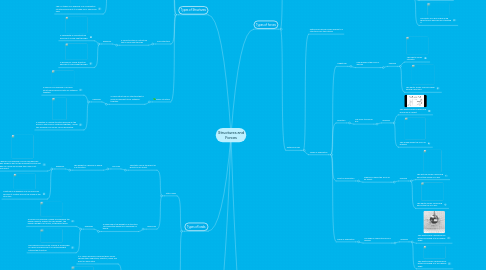
1. Types of Structures
1.1. Shell strucure
1.1.1. A shell is a structure that is covered on the outside and hollow in the inside.
1.1.1.1. examples
1.1.1.1.1. An snail shell is an example of a shell structure because it covered with shell and it is hollow on the inside.
1.1.1.1.2. An egg is a shell structure because it is shaped like a shell and is hollow in the inside.
1.2. Combination structure
1.2.1. A combination structure is made up of shell, solid and frame structures.
1.2.1.1. examples
1.2.1.1.1. A house is an example of combination structure because it has a frame to help support it and it is hollow on the inside.
1.2.1.2. The CN tower is an example of a combination structure because it it is made up of frame and shell.
1.3. Solid structure
1.3.1. A solid structure is a structure that is solid right through.
1.3.1.1. examples
1.3.1.1.1. A sandcastle is solid structure because it is hard right through.
1.3.1.1.2. A diamond is a solid structure because it is solid right through.
1.4. Frame structure
1.4.1. A frame structure is a structure that is made of different items fastened together.
1.4.1.1. examples
1.4.1.1.1. A bicycle is an example of a frame structure because all parts are fastened together.
1.4.1.1.2. A skeleton is a frame structure because all the bones in your body is fastened together, I know this because your bones can be dislocated.
2. Types of loads.
2.1. Static loads
2.1.1. The static load is the effect of gravity on an object.
2.1.1.1. Live load
2.1.1.1.1. The weight of a person or goods in a structure.
2.1.2. dead load
2.1.2.1. A dead load is the weight on a structure ,excluding the weight of a passenger or goods.
2.1.2.1.1. examples
2.2. Dynamic loads
2.2.1. The dynamic load is the forces that move while acting on a structure.
2.2.1.1. It is called "Dynamic" because these forces change their magnitude, direction, plane and point of application
2.2.1.2. example
2.2.1.2.1. Winds are examples of a dynamic load because it blows on the structure.
2.2.1.2.2. Rain shows dynamic load because it falls on the outside of the structure.
3. Form and functions
3.1. Function is the first and most important thing when it comes to creating a structure.It is important because you need to know how it would look and function when it is finish. After that you can determine how the shape is going to look.
3.1.1. example
3.1.1.1. This picture shows how a will function
3.1.1.2. This photo shows the shape of the house when finished.
4. Types of forces
4.1. Internal forces
4.1.1. Internal forces are forces that cause a part of the structure to exert another part in the same structure.
4.1.1.1. Compression
4.1.1.1.1. A force that presses something together.
4.1.1.2. Shear
4.1.1.2.1. A force that pushes in opposite directions.
4.1.1.3. Tension
4.1.1.3.1. A force that stretches apart to expand.
4.1.1.4. Torsion
4.1.1.4.1. A force that twists.
4.2. External forces
4.2.1. External forces are forces applied to a structure from the outside.
4.2.2. Types of application
4.2.2.1. Magnitude
4.2.2.1.1. How powerful the force is applied.
4.2.2.2. Direction
4.2.2.2.1. The force to push or pull.
4.2.2.3. Point of application
4.2.2.3.1. Where you apply the force on an object.
4.2.2.4. Plane of application
4.2.2.4.1. The angle in which the force is applied.
5. Centre of Gravity
5.1. Centre of gravity
5.1.1. The point in which weight is evenly dispersed and all sides are balanced.
5.1.1.1. example
5.1.1.1.1. This picture shows a centre of gravity.
5.1.1.1.2. This photo shows a person and their centre of gravity when moving.
5.2. Ways to make a structure stable.
5.2.1. Design the structure with a wide base.
5.2.1.1. example
5.2.1.1.1. This photo shows a bottle and how it is stable with a lager base.
5.2.1.1.2. This photo shows the Eiffel tower and how it has a large base.
5.2.2. Add more support beams.
5.2.2.1. example
5.2.2.1.1. This photo shows a bridge with support beams.
5.2.2.1.2. This photo shows a transmitter with support beams.
5.2.3. Make the base heavier.
5.2.3.1. example
5.2.3.1.1. This photo shows a dish washer and how it is stable with a heavier base.
5.2.3.1.2. This photo shows a container and how it is stable with a heavier base.

